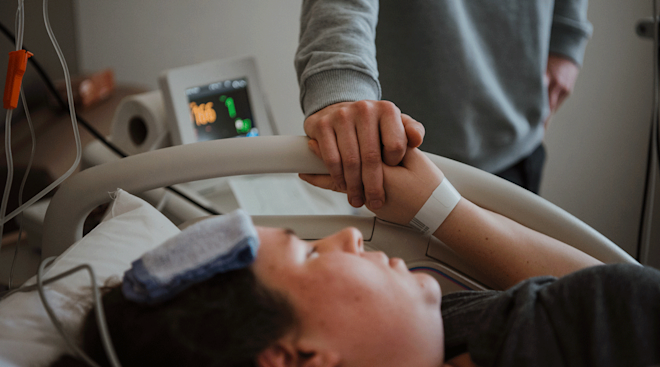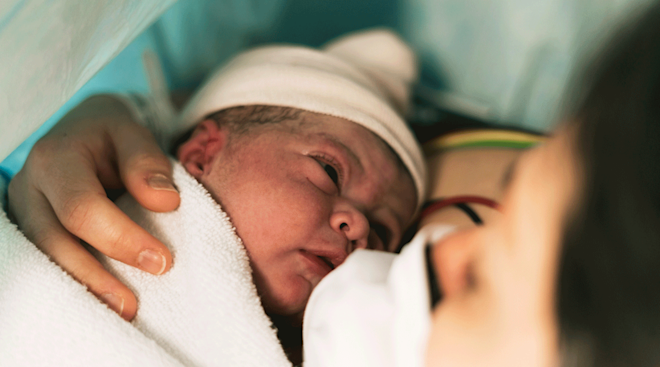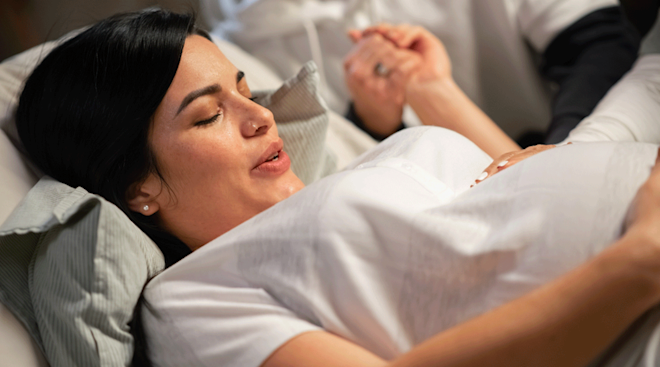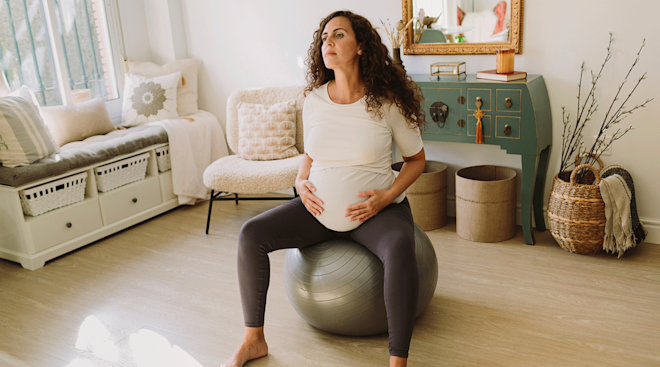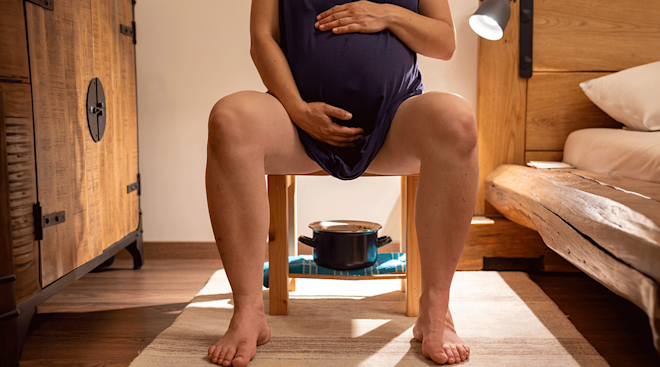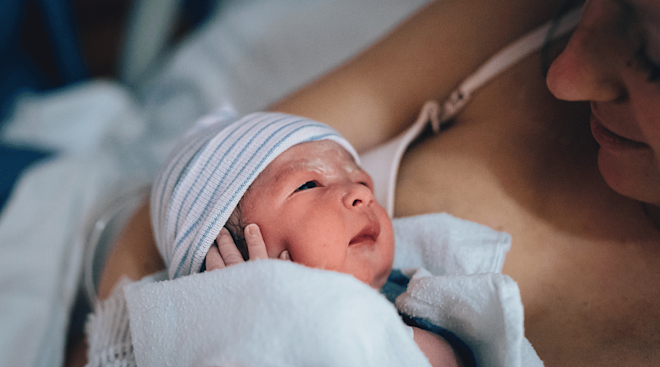Does Curb Walking Help to Induce Labor?
There are tons of anecdotal stories out there about natural ways to induce labor at home—and one of them is by curb walking. But exactly what is curb walking—and does it actually work? We asked two prenatal experts for the lowdown on this special type of stroll. Here’s everything they want you to know about trying curb walking to induce labor.
Curb walking is pretty much exactly what it sounds like—walking on the curb as a natural, at-home method of labor induction. It involves walking with one foot up on the curb and one foot on the street. “This lopsided walking helps to open the pelvis and, hopefully, allows the head to descend into a good position [before birth],” says Lisa Jackson, MD, FACOG, an ob-gyn and partner at Uptown OBGYN of New York.
Does curb walking really induce labor? It’s important to note that labor induction is a biologically complex process that requires many moving pieces. So curb walking isn’t a guaranteed way to kick start labor—but it may help expedite things. The idea is that curb walking helps create space in the pelvis, enabling baby to move lower and get properly positioned before childbirth. “Their head puts more pressure on your cervix, which stimulates the release of labor hormones and promotes continued dilation of your cervix,” explains Rebekah Mustaleski, CPM-TN, a certified professional midwife and compression director with Motif Medical.
Is curb walking to induce labor effective?
Both experts note that curb walking on its own likely won’t induce labor. That said, “it can help move things along,” Mustaleski explains. This is especially true if you’re close to your due date, know you’re going to be induced or are already in early labor.
I didn’t try curb walking (I didn’t even know it was a thing!), but I did walk laps around my neighborhood almost every day to help encourage dilation as my due date approached. And when I finally went to the hospital with contractions, my OB instructed me to circle the maternity ward for an hour and then come back to my room to get checked. I felt like I was making rounds in my hospital gown. I waved to anyone and everyone with an open door!
Does regular walking help to induce labor?
Walking won’t “put you in labor if your body isn’t ready to go into labor,” Mustaleski says, but, again, it can help prepare your body for birth. She suggests walking throughout your pregnancy for 30 minutes each day as long as you’re cleared by your provider, as it can have several benefits (more on this below).
As long as you’re paying attention to your footing and balance, as well as your surroundings, curb walking to induce labor is safe. “There’s no downside to trying it, but if it hurts then stop,” Jackson says. Plus, curb walking can have several benefits, Mustaleski adds, including increased pelvic mobility and encouraging the optimal birth position for baby, both of which can help you have an easier delivery. Not to mention, it counts as physical activity. In fact the American College of Obstetricians and Gynecologists (ACOG) recognizes walking as a great full-body prenatal workout that’s easy on your muscles and joints.
When to avoid curb walking
There are some circumstances in which curb walking to induce labor may not be recommended. If your provider has limited your physical activity or put you on pelvic rest, you may need to abstain from this activity. Other conditions in which curb walking to induce labor isn’t recommended include if you have:
- Placenta previa
- Pelvic girdle pain
- Symphysis pubis dysfunction
- Increased risk of preterm labor
- A scheduled c-section for any reason
- Are not yet at or past 36 weeks gestation
I curb walked, and contractions kicked in later that night. Baby arrived the next morning!
Both experts say you can start curb walking to induce labor late in the third trimester after 36 weeks. However, as noted, Mustaleski encourages walking throughout the duration of pregnancy. Curb walking can certainly be a part of your regular prenatal walks, as it may help shift your pelvic bones and create flexible tissues and ligaments in your hips and pelvic floor. “This mobility is best created gradually, over time and is necessary for birth because those tissues have to stretch and move to allow baby to pass through,” Mustaleski explains.
She adds that curb walking can also be beneficial during pregnancy if you’re experiencing prodromal labor, which is when contractions last for hours but don’t cause any cervical changes. “Sometimes prodromal labor happens because baby isn’t in the best position and curb walking can sometimes fix that.” Curb walking may also be helpful in the following situations:
- In early labor if you’re experiencing contractions, cramping and loss of the mucus plug
- If you’re close to or past your due date
- If baby’s still sitting higher up in the pelvis close to your due date
Mustaleski recommends walking for a minimum of 30 minutes daily and incorporating curb walking into that time. For curb walking specifically, Jackson also suggests walking in one direction for 10 minutes and then switching legs to walk in the opposite direction for another 10 minutes. “You can do it once a week to every day. There’s no set duration or frequency that has a proven benefit,” Jackson adds.
Along with this, here are a few other key components to keep in mind:
- Your surroundings: “You definitely want to be aware of your surroundings while you’re curb walking,” Mustaleski says. “Watch for traffic, broken curbs and other changes in your environment.” You also want to avoid busy streets and construction areas, Jackson adds.
- Wear supportive shoes: Both experts stress the importance of wearing supportive shoes during pregnancy. Your center of gravity will change as pregnancy progresses, and you’ll need shoes to help support you (sorry flip-flop lovers!).
- Move indoors: If it’s too hot, cold or dangerous to curb walk outside, know you can do the exercise at home. Mimic the high-low movement with a step stool, yoga block or stair, Mustaleski says.
- Listen to your body: It’s important to listen to your body while curb walking in pregnancy, as you would for any more rigorous exercise. If you have pain at any point, it’s important to stop and rest, Jackson says.
I walked every day, and I was still sealed up like Fort Knox on the day of induction. She was just not ready for the world in 2020.
There are some other ways to potentially induce labor naturally at home aside from curb walking, Mustaleski notes. These include:
- Eating dates
- Having an orgasm
- Exercising
- Trying nipple stimulation
While these at-home strategies are generally safe to try with your provider’s approval, Jackson says the safest way to encourage spontaneous labor is with a membrane stripping in your provider’s office. They’ll sweep their fingers across the membranes connecting the amniotic sac to your uterus. Further, “if labor needs to be induced for a medical reason, the safest way to do this is in the hospital with appropriate medication and supervision of Mom and baby,” Jackson adds.
If you’re close to meeting baby, you’re likely eager to get the labor and delivery process started. While there’s usually no harm in trying curb walking to induce labor, always check with your provider first.
Please note: The Bump and the materials and information it contains are not intended to, and do not constitute, medical or other health advice or diagnosis and should not be used as such. You should always consult with a qualified physician or health professional about your specific circumstances.
Plus, more from The Bump:
Lisa Jackson, MD, FACOG, is an ob-gyn with over 15 years of experience and a partner at Uptown OBGYN of New York. She earned her medical degree from Vanderbilt University School of Medicine in Nashville, Tennessee and completed her residency in Chicago at Rush University Medical Center. She also serves as an assistant clinical professor of ob-gyn at the Mount Sinai Hospital in New York City.
Rebekah Mustaleski, CPM-TN, IBCLC, is a certified professional midwife specializing in evidence-based maternity care. She co-founded Roots & Wings Midwifery in Knoxville, Tennessee. Mustaleski received her bachelor’s degree in psychology from Centre College and worked as a doula and birth photographer prior to establishing Roots & Wings.
American College of Obstetricians and Gynecologists, Exercise During Pregnancy, March 2022
Learn how we ensure the accuracy of our content through our editorial and medical review process.
Navigate forward to interact with the calendar and select a date. Press the question mark key to get the keyboard shortcuts for changing dates.








































